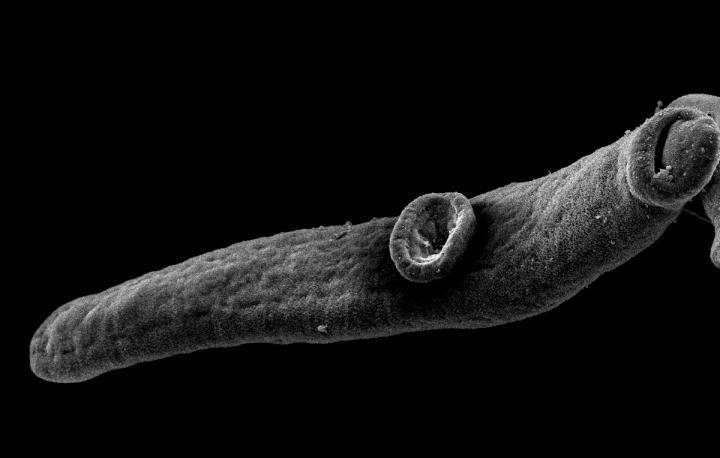It has been known for decades that parasitic infections have a dramatic effect on the human immune system. For instance, some evidence suggests that certain allergic reactions are due, in part, to IgE molecules responding to antigens that are similar to proteins found on various parasitic worms, causing the immune system to overreact. What has been less well understood is the immune response to coinfections of parasites and pathogenic bacteria like Helicobacter pylori.
Now, a new study from investigators at the Technical University of Munich (TUM) has completed the first study of the effects of simultaneous infection with blood flukes (schistosomes) and H. pylori—a common occurrence in some parts of the world. Findings from the new study were published recently in Cell Reports through an article titled “Concomitant Infection of S. mansoni and H. pylori Promotes Promiscuity of Antigen-Experienced Cells and Primes the Liver for a Lower Fibrotic Response.”
Around 240 million people worldwide are afflicted with schistosomiasis, an illness caused by flatworms of the genus schistosoma, commonly known as blood flukes. These parasites generally enter the human body with water from lakes, ponds, or rivers. Worms, larvae, and eggs are transported to various organs in the body through the bloodstream. The species Schistosoma mansoni is especially damaging to the liver, where it causes cirrhosis.
H. pylori is a bacterium that colonizes the human stomach. One in three people in Germany carry it and the worldwide rate is actually around 50%. Infections are associated with stomach ulcers and cancer. In places where schistosomes are widespread, as in some African countries south of the Sahara, coinfections with H. pylori are frequent. A research team that is part of the Institute for Medical Microbiology, Immunology, and Hygiene at TUM used mice to study what happens in a coinfection with H. pylori and S. mansoni.
In a schistosomiasis infection, the initial infection is followed by an acute phase, superseded about five weeks later by a chronic phase. In their study, the researchers showed that fewer T cells were found in the stomach during the acute phase of schistosomiasis. In hosts infected only by H. pylori, these immune cells are more numerous in the stomach and cause inflammation there.
“We show that the schistosomiasis drives an increase in chemokine levels in the liver. The chemokines attract the T cells and, in a sense, misdirect them to the liver,” said co-senior study investigator Markus Gerhard, PhD, professor at TUM. “This leads to a reduction in stomach inflammation.”
The study authors added that “we investigated the effects of coinfection during the different immune phases of S. mansoni infection. “Surprisingly, coinfected mice had increased H. pylori gastric colonization during the interferon-gamma (IFNγ) phase of schistosome infection but reduced infiltration of T cells in the stomach due to misdirection of antigen-experienced CXCR3+ T cells to the liver. Unexpectedly, H. pylori coinfection resulted in partial protection from schistosome-induced liver damage. We demonstrated that an increase in fibrosis-protective IL-13Ra2 is associated with H. pylori infection. Thus, our study strongly points to an immunological interaction of anatomically isolated pathogens, eventually resulting in altered disease pathology.”
This effect fades away when the chronic phase begins, however. While hosts infected with schistosomiasis alone often suffer liver damage during that phase, this is less common with coinfections. In their investigations, the researchers elevated quantities of the signaling protein IL-13dRa2 in the blood of mice infected with the bacteria.
“IL-13dRa2 can provide protection against cirrhosis and can even reverse tissue changes,” noted senior study investigator Clarissa Prazeres da Costa, PhD, professor at TUM. “We, therefore, believe that they could play a decisive role to reduce the extent of liver cirrhosis in coinfections. In everyday life, many people are repeatedly re-infected with schistosomes because they come into frequent contact with water containing the worms. As a result, there is no time limit on the diversion of T cells to the liver because the chronic and acute phases occur simultaneously.”
At first glance, the interactions in case of a coinfection may look like a positive side effect: Although the infected individual is suffering from two illnesses, the harmful effects of both are seemingly reduced.
“Coinfections can have other consequences, however. For example, the changed immune response can limit the effectiveness of vaccines,” Gerhard concluded. Prazeres da Costa added that, “Coinfections are widespread especially in poorer regions. We urgently need more studies on their effects and ways of dealing with them, for example in order to develop new and more effective vaccination strategies.”


